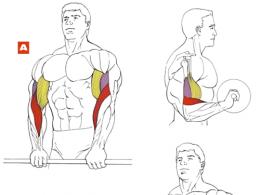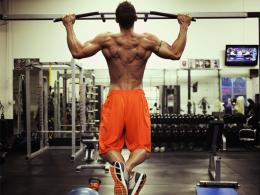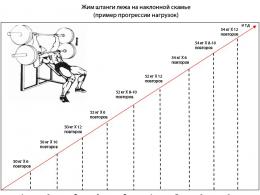Bending the arms with a barbell with a reverse grip while standing. Reverse barbell curl. Work of muscles and joints
Bending the elbows is the main movement for training the biceps brachii, and when performed with a reverse grip, the load mainly falls on the lower sections of the biceps, the brachialis muscle, and numerous muscles of the anterior surface of the forearm. This exercise is aimed at shaping those muscles that are adjacent to the elbow joint, and in most athletes they are less developed than other muscles of the hands.
Target Muscles
B biceps of the shoulder, brachial, brachioradialis muscles.
Auxiliary: almost all the muscles of the anterior surface of the forearm.
Exercise technique
- We lower our shoulders down, press our elbows to the body. Work only due to flexion in the elbow joint, all other muscles are rafted.
- We do not throw the bar far up.
- Unlike lifting the barbell for biceps while standing, in this exercise you need to unbend your arms completely at the bottom point.
- Exhale on effort, slowly lower.
- The more you use the grip, the more your brachioradialis muscle is involved in the work.

Do not train with a barbell that is too heavy, otherwise you will not be able to perform the exercise correctly due to the fact that the weaker brachial muscle plays a primary role in this variation of arm curls, and the biceps only helps it.
Keep your body straight at all times, do not bend forward. When curling your arms, especially in the last repetitions, do not help yourself with a movement in the lower back. This is cheating, which should be avoided if possible, which is done very simply by reducing the weight on the bar and tight contact of the elbows and torso when doing bicep curls.
Do not allow the hands to bend at different angles in the wrist joint - this can lead to injury, and greatly changes the degree of load distribution between muscle groups towards the muscles of the forearm.
Video "Barbell curls for biceps with a reverse grip"

The Reverse Barbell Curl is one of the best forearm exercises.
The shoulder muscle is very rarely pumped, since most people focus on pumping and building up the biceps, since this muscle catches everyone's eye.
But, do not forget that if you pump the brachialis, then the total mass of the biceps will be much larger and larger. Thanks to the shoulder muscle, the width and volume of the arms increases significantly.
Main working muscle group: biceps brachii, brachialis ( brachialis )
Auxiliary muscle group: brachioradialis muscle ( brachioradialis )
Bending the arms with a barbell with a reverse grip - execution technique.
1. Take a barbell with a curved neck, although you can use a straight neck, as you like, with an overhand grip, the distance between the hands is about the width of the shoulders.
2. Take the starting position by slightly bending back, taking the correct posture. Legs in a stable position.
3. While inhaling, slowly lift the bar to your chest, but touching it.
4. Elbows are in the same position and pressed to the body, make sure that they do not "walk" back or forward.
5. As you exhale, slowly lower the weight to the level of your hips.
6. Do not take too heavy weights, otherwise you will not be able to perform the exercise correctly, because in the first place in this option (grip from above), the weakest shoulder muscles are included in the work, and the biceps itself plays a secondary role and only helps them.
7. Do not lift the bar too high, as the amplitude here is less than with a normal barbell lift for biceps.
8. Among other things, this exercise technique reduces the load on the trained muscles and the higher you lift the weight, the less the biceps and forearm will work.
9. Keep your torso straight at all times, especially on the last reps. Therefore, set the weight so as to avoid bending in the lower back when lifting the bar or reduce the weight, everything is simple.
10 Do not bend the hands at different angles, in the wrist joint - injury is possible!
Bending the arms on the lower block with a reverse grip is aimed at high-quality study of the shoulder, brachioradialis muscles and biceps. But oddly enough, it is the latter (biceps) that are least involved in this exercise. Therefore, the main load falls on the forearm. But, in addition to the growth of the forearms, thanks to this exercise, you can achieve an increase in the volume and upper arms. This is due to the growth of the shoulder muscle, which, in turn, increases, and gives relief and volume to your arms. Technically, this exercise is identical. The only difference is that it is not done with free weights.
Technique for performing bending of the arms on the lower block with a reverse grip:
- Stand near the simulator.
- Take the handle of the simulator with a grip from above (palms look down).
- Stand straight, feet shoulder-width apart.
- Inhale, and then as you exhale, lift the handle of the simulator up, bending your elbows.
- Hold your hands in this position for a moment and then slowly lower the handle down to its original position while inhaling.
- When it reaches the bottom point, repeat the curl for the given number of repetitions.
Muscles involved in exercise

Features of bending the arms on the lower block with a reverse grip:
- Do not swing your body, thereby helping yourself to bend your arms.
- Lower the handle slowly from the top. Why is it necessary? The muscles of the forearm (at the moment, this is our target muscle group) work both in the positive phase (flexion of the arms at the elbows) and in the negative phase of the exercise (extension of the arms, or lowering the handle of the simulator down). Passing the negative phase of the exercise slowly, you can feel that the muscles of the forearm are being worked out much better.
- Do not bring your elbows forward while bending your arms.
- The forearm is a fairly hardy muscle group, so the number of repetitions can be increased to 15-20.
Video: Reverse Barbell Lift
This exercise is the main one for increasing the mass of the biceps. During the lifting of the bar for the biceps, the brachioradialis muscles of the forearm are involved. The barbell curl is one of the most popular exercises among athletes. Any training program necessarily includes this exercise to build strength and volume of the biceps.
In order for such an exercise to bring results, you need to know some of its nuances and master certain techniques. Consider the main features of such an exercise.
Bending the arms with a barbell: a description of the exercise
So, during the lifting of the bar, it is the biceps muscles that take on the main load. Depending on which grip the athlete uses, muscle growth will occur in different ways.
- Upper and middle part of the trapezius muscle;
- Scapular levator;
- Muscles that flex the wrist.
The benefits of this exercise are obvious:
- In one exercise, muscle parameters such as strength, size, endurance, definition are trained;
- The exercise has free weight and allows you to use free weight, and therefore the biceps will be qualitatively loaded;
- Biceps can be comprehensively worked out due to the variability of execution methods;
- The neck of the bar is chosen so that it provides a minimum load on the back.
Lifting the bar with a reverse grip: execution technique
Reverse barbell lift
In most cases, the technique for lifting the barbell for biceps leaves much to be desired. Apparently, this is due to the fact that such an exercise is common, and many athletes mistakenly believe that they know everything about it, and continue to do it with mistakes. Steps for this exercise:
- The equipped barbell must be taken with a shoulder-width grip. Feet should also be shoulder width apart. Knees - bent, palms facing forward. The abdominal muscles are tense. This is what the starting position looks like.
- Shoulders are motionless. The bar rises up due to the forearms and the strength of the biceps. This movement is done until the biceps contract. The bar must be raised to shoulder level and held for one or two seconds. When lifting the bar, exhale.
- The bar slowly returns to its original position. At this time, exhalation is done.
In order for the exercise to be beneficial and contribute to the growth of mass and endurance of the biceps, it is necessary to adhere to the following recommendations:
- all movements must be done cleanly, without swinging or shaking the barbell;
- the bar should be raised as wide as possible;
- as soon as the bar reaches the highest point, it is necessary to hold it for a few seconds;
- lowering the bar should be slower than raising;
- the barbell does not need to be thrown;
- arms at the lowest point do not straighten;
- between sets, it is necessary to stretch the biceps, and it is better to start training with this exercise;
- for strength, you need to do five sets of 3-5 repetitions. For volume, 3 sets of 15-20 repetitions are enough.
Bending the arms with a barbell with a reverse grip on the bench
To do this, you need to pay attention to such stages of the exercise.
- Sit on the bench, put your feet on the stand and take the barbell wide.
- Raise it to face level.
- Slowly lower the bar to its original position.
You can change the angle of the bench, the width of the grip and the range of motion. In all these cases, the load is distributed differently. When doing these exercises, you should leave the barbell in a slightly bent position. Thus, the intensity of the exercise can be ensured.
- The arms are always in a pronated position, so the biceps are almost completely excluded from work.
- The main part of the load goes to the brachioradialis muscle, since it does not perform a twisting function in this exercise.
- This type of flexion works much better on the lateral part of the forearm.
Curls are very good at strengthening the wrist extensors, so the athlete's grip becomes stronger. This is very important if the athlete plans to work with large weights in the future. In addition, overhand barbell curls are often included in training for boxers, as they allow you to increase punching power.
Correct technique
At first glance it may seem that this exercise is too simple, but it is not entirely true. If you lift the bar incorrectly, you will increase the risk of nasty injury. Therefore it is necessary:
- Take the barbell with an overhand grip, place your hands approximately shoulder-width apart.
- The bar is at the same level with the hips. It is from this point that it begins to rise to the level of the chest. In this case, the elbow joints are bent towards themselves, but not to a perpendicular position with the floor.
- As you exhale, the bar gently lowers to its original position.
- When lifting weights, it is necessary to reduce the movement of the elbows. They are tightly pressed against the body of the athlete.
This exercise is always performed at the end of the workout, as it strains the muscles of the forearms very much. However, after curling the barbell, it is important to perform a wrist curl with a barbell underhand grip in order to finally "hammer" the muscles. It is enough to do 3 sets of 15 reps with a comfortable weight, and the muscles will get a good load.
Safety
 To protect yourself from all sorts of injuries, you need to work with a small weight. No need to immediately chase massive rods. Beginners are advised to use an empty bar or train with light dumbbells. This will help you master the technique perfectly, and also protect you from stretching your hands and elbow joints.
To protect yourself from all sorts of injuries, you need to work with a small weight. No need to immediately chase massive rods. Beginners are advised to use an empty bar or train with light dumbbells. This will help you master the technique perfectly, and also protect you from stretching your hands and elbow joints.
In no case no need to help yourself swaying while lifting. With such a movement, not only does the effectiveness of the entire exercise decrease, but it also increases the risk of injuring your back. If the back does not “want” to be excluded from work, then you need to try the same exercise, but with less weight.
In some cases, this kind of bending is performed together with a belaying companion. It will help you hold the bar when your muscles are completely tired, because otherwise you will have to throw it to the floor, which can injure your legs or arms.
Common Mistakes
 The main mistake is "breaking" of the brushes when lifting. This can happen not only when working with a lot of weight, but even when performing an exercise with an empty neck. As a rule, this mistake is made by beginners who cannot properly hold the barbell. If the hands continue to "break", then this will lead to rapid fatigue of the joints. As for weightlifters, this exercise can be dangerous for them when they work with a lot of weight.
The main mistake is "breaking" of the brushes when lifting. This can happen not only when working with a lot of weight, but even when performing an exercise with an empty neck. As a rule, this mistake is made by beginners who cannot properly hold the barbell. If the hands continue to "break", then this will lead to rapid fatigue of the joints. As for weightlifters, this exercise can be dangerous for them when they work with a lot of weight.
Some athletes begin to perform this exercise at the start of the workout, and then they complain that they cannot finish the set in a quality manner. And it is not surprising, because the muscles of the forearm begin to receive excessive stress, so they quickly get tired. Because of this, curls are usually performed at the end of a workout or in the middle of it, when the muscles will be at their maximum tone.
The bending of the arms should not be very fast or jerky.. The fact is that any sudden movement can damage the joint and knock the athlete out of the usual training regimen for a long time.
Equipment
To complete the exercise, you will need a straight or W-shaped bar, as well as weight discs. From additional equipment, you can use sports gloves to prevent your hands from slipping off the neck, as well as an athletic belt if you are not sure that you can keep your back in a stable position.

- You need to understand that this exercise primarily trains the muscles of the forearms, and not the biceps. For this reason, before performing bending, it is necessary to load this particular muscle group well.
- The grip should always be shoulder width apart. If you decide to use a curved bar, then the forearm will receive less load, since part of it will go to the biceps.
- Arms always unbend to the end, but you do not need to bend them just as well. The hand remains slightly in front of the elbow joint, which will force the biceps to tighten as much as possible at the top of the amplitude.
- It is important to keep the elbows pressed to the body, but during the removal of the barbell, they should go forward a little. This is done to better work out the biceps.
- Do not swing and push the weight with your back. Such movements are allowed only on the last repetitions, when the athlete does not have the strength left to “cleanly” complete the set.
- If you can’t do 8 reps well, then it is recommended to reduce the weight.
Conclusion
The overhand barbell curl is a good way to complete your arm workout. This exercise effectively works out the muscles of the forearms, making them strong and resilient. This type of bending should definitely be included in the training of boxers and weightlifters working with heavy weights in the bench press.






